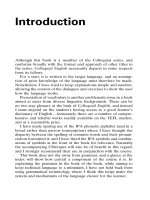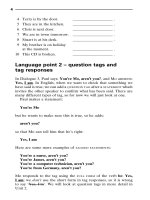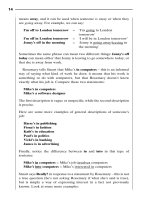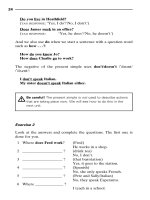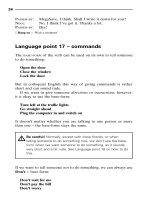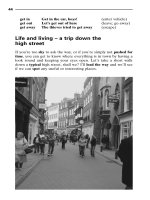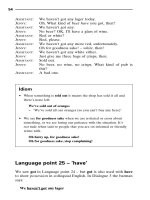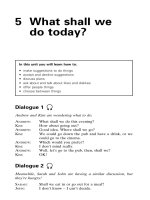A complete English language course part 3
Bạn đang xem bản rút gọn của tài liệu. Xem và tải ngay bản đầy đủ của tài liệu tại đây (148.9 KB, 10 trang )
4 Terry is by the door. ____________________ .
5 They are in the kitchen. ____________________ .
6 Chris is next door. ____________________ .
7 We are in town tomorrow. ____________________ .
8 Stuart is at his desk. ____________________ .
9 My brother is on holiday
at the moment. ____________________ .
10 This CD is broken. ____________________ .
Language point 2 – question tags and
tag responses
In Dialogue 3, Paul says: You’re Mo, aren’t you?, and Mo answers:
Yes, I am
. In English, when we want to check that something we
have said is true, we can add a
QUESTION TAG
after a
STATEMENT
which
invites the other speaker to confirm what has been said. There are
many different types of tag, so for now we will just look at one.
Paul makes a statement:
You’re Mo
but he wants to make sure this is true, so he adds:
aren’t you?
so that Mo can tell him that he’s right:
Yes, I am
Here are some more examples of
TAGGED STATEMENTS
:
You’re a nurse, aren’t you?
You’re James, aren’t you?
You’re a computer technician, aren’t you?
You’re from Germany, aren’t you?
Mo responds to the tag using the
FULL FORM
of the verb be: Yes,
I am
; we don’t use the short form in tag responses, so it is wrong
to say ‘Yes, I’m
’. We will look at question tags in more detail in
Unit 2.
4
Exercise 2
Add the correct question tags to these sentences – the first one has
been done for you.
1 You’re a teacher, aren’t you?
2 Simon’s a footballer, ______ ?
3 Suzie’s a nurse, ______ ?
4 Pete and Dave are lawyers, ______ ?
5 Ela’s from Poland, _____ ?
6 This food’s delicious, ____ ?
7 We’re a bit late, ____ ?
8 It’s cold this morning, ____ ?
9 You’re from Finland, ____ ?
10 Ilse’s from Austria, ____ ?
Dialogue 4
Rosemary wants to introduce Justine and Tim to Stuart, who doesn’t
know them.
R
OSEMARY
: Stuart, this is Justine.
S
TUART
: Hello, Justine.
J
USTINE
: Pleased to meet you, Stuart.
R
OSEMARY
: And this is Tim.
T
IM
: Hello, Stuart.
Dialogue 5
Justine introduces Vicki to Chris.
J
USTINE
: Vicki – do you know Chris?
V
ICKI
: I don’t think so.
J
USTINE
: Chris, this is Vicki.
C
HRIS
: Hello Vicki.
V
ICKI
: Hello Chris. Pleased to meet you.
Language point 3 – introducing people
You can find out if someone knows someone else, or introduce two
people who don’t know each other, by asking one of them Do you
know . . .? followed by the name of the other person.
1111
2
3
4
5
6
7
8
9
10
11
1211
13
14
15
16
17
18
19
20
21
22
23
24
25
26
27
28
29
30
31
32
33
34
35
36
37
38
39
40
41
4211
5
Vicki answers with I don’t think so, not because she isn’t sure
but because this is a more indirect way of saying No – it would
sound rather short just to say ‘No’. Let’s look at another example
of two people being introduced to each other:
Dialogue 6
Stuart is seeing if he can remember the names of everyone in the
room.
S
TUART
: Now then, are you Helen?
H
ELEN
: Yes, I am.
S
TUART
: And is that Su by the door?
H
ELEN
: Yes, it is.
Stuart turns to another person.
S
TUART
: And are you Jenny?
J
ENNY
: Yes, I am!
Stuart points to someone else.
S
TUART
: And is she Ann?
J
ENNY
: Yes she is! Well done!
Dialogue 7
Su is talking to Shamira in the office.
S
U
: Is the coffee ready?
S
HAMIRA
: Yes, it is.
S
U
: Good. Where’s the sugar?
S
HAMIRA
: It’s over there on the table.
Su looks for the sugar.
S
U
: Are you sure, Shamira?
Shamira looks as well.
S
HAMIRA
: Oh no – here it is, on Tim’s desk.
S
U
: Is Tim off today?
S
HAMIRA
: Yes, he is. He’s ill.
S
U
: Poor Tim. Coffee for two, then?
6
Language point 4 – questions with the
verb ‘be’
We turn statements using the verb be into questions by simply
changing the order of the pronoun (I, you, he, she, it, etc.) and verb
in the full form. So:
Statement (full form) Question
I am am I?
you are are you?
he is is he?
she is is she?
Kevin is is Kevin?
we are are we?
they are are they?
Ann and Jenny are are Ann and Jenny?
Notice that there is no short form for questions: for example, instead
of he is we usually say he’s, but we cannot say ‘’s he?
’ instead of
is he?
(Most verbs in English don’t form questions in this way, as we
will see in later units – but this is always the way to make questions
with be.)
Exercise 3
Turn these statements into questions – remember to use full forms!
The first one has been done for you.
1 I’m late. Am I late?
2 Dave’s off work today. _______________ ?
3 It’s cold outside. _______________ ?
4 We’re in the right place. _______________ ?
5 Everyone’s ready. _______________ ?
6 You’re tired. _______________ ?
7 They’re in the garden. _______________ ?
8 Morgan and Eddie are here. _______________ ?
9 Oliver’s outside. _______________ ?
10 Jenny’s inside. _______________ ?
1111
2
3
4
5
6
7
8
9
10
11
1211
13
14
15
16
17
18
19
20
21
22
23
24
25
26
27
28
29
30
31
32
33
34
35
36
37
38
39
40
41
4211
7
Dialogue 8
Brian is having trouble with names and faces.
B
RIAN
: Is that Gerry over there?
S
TUART
: Yes, it is.
B
RIAN
: And who’s that with him?
S
TUART
: That’s Ben.
B
RIAN
: And where’s Sandra?
S
TUART
: She’s over there, by the window.
B
RIAN
: Oh yes – and who’s that with her?
S
TUART
: That’s Dave.
Dialogue 9
Ben has a list of names of people in the office, but he doesn’t know
who’s who! He asks Justine to help, and she points them out as he
reads out the names.
B
EN
: Right. Where’s Helen?
J
USTINE
: That’s her, by the door.
B
EN
: And Stuart?
J
USTINE
: That’s him, at the computer.
B
EN
: And what about Gerry and Adrian?
J
USTINE
: That’s them, by the coffee-machine.
B
EN
: And finally what about Justine?
J
USTINE
: That’s me, silly!
8

